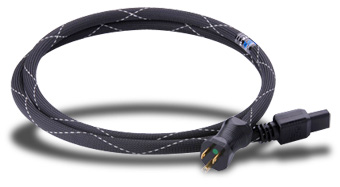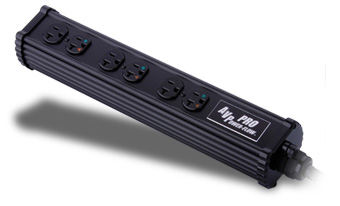 |
| June 15, 2007 Essential Sound Products AVP-14 Power Cord and A/V Power-Flow Pro Power Distributor
Now ESP has evolved a new species of power cord and power distributor. At less than half the cost of the Essence Reference, the AVP-16 (16-gauge conductors, $199 USD per 2m cord) and AVP-14 (14-gauge conductors, $299/2m cord) are designed, as the ESP website says, to address "flat dynamics, thin harmonics, and gutless sound without full and extended bass." The solution provided by the AVPs is not merely heavier-gauge wire, but power cords specifically designed to present audio gear with "abundant power, delivered fast, without impedance anomalies that cause frequency and timing distortions and a loss of musical realism." My current audio system thankfully doesn’t suffer from any components or cables whose sound I would label "gutless," but I was intrigued by the opportunity to test a new model of power cord likely to have benefited from the strengths of its esteemed ancestor. So, one pleasant spring morning, a batch of AVP-14 power cords arrived at our house, accompanied by an ESP A/V Power-Flow Pro power distributor ($599). The Essence of ESP’s Audio/Video Professional Series Michael Griffin, founder and president of Essential Sound Products, created the AVP power cords to be entry-level audiophile products. "We wanted them to have many of the same design features as the Essence Reference, but be fully mass-produced," he told me. Mass production keeps costs down, and strict safety testing permits the AVPs to be used with greater confidence in professional audio applications and custom installations. Safety and reliability are important, of course, but may not be the first things on an audiophile’s list of desirable qualities in a power cord. "When we got the first preproduction AVP units, I was surprised how good they sounded -- better than I expected," said Griffin. Given the similarities between the designs of the AVP series and the Essence Reference, maybe that’s a testament to solid engineering. "The AVP cord is what engineering gets you," Griffin continued. "The Essence Reference is what engineering plus tweaking and using the best materials get you." Also at the heart of the AVP-14 is the patented multi-conductor geometry of the Essence Reference. Multiple strands of oxygen-free, high-conductivity (OFHC) copper are compacted under pressure to form the conductors, including a 12-gauge wire for the ground. The larger ground wire is said to contribute to a lower noise floor. The AVP-14 also has a braided copper shield with 90-95% coverage. Its custom-molded plugs and IEC connectors have solid brass contacts and are both crimped and soldered to the conductors. The Essence Reference differs in using solid conductors and higher-grade connectors, and its cable is crimped to its connectors without soldering. It’s also cryogenically treated, which Griffin believes isn’t practical for the mass-produced AVP models.
I let the entire set of AVP-14 cords and Power-Flow distributor burn in for about a week before settling down to serious listening. Associated equipment for the listening tests included Triangle Stratos Australe speakers, a Conrad-Johnson Premier 350 power amp, a Bent Audio NOH passive transformer-based line stage, a Cary Audio 306/200 CD player, a PS Audio Premier Power Plant power conditioner, an AudioQuest NRG-3 power cord, and Legenburg Iris interconnects, speaker cables, and power cords. Listening ESP’s owner’s manual suggests a burn-in period of 24-48 hours, but I kept hearing changes in the sound for at least the first 100 hours of use, maybe more. After being reasonably certain that burn-in was completed, I immediately tried to answer the question that had been on my mind ever since I knew I’d be reviewing the AVPs: What do they do with bass? The reputation of the ESP Essence Reference is built partly on its ability to let the bass speak, and I wanted to hear what its offspring could do. I cued up "The Gates of Istanbul," track 2 of Loreena McKennitt’s An Ancient Muse [CD, Verve B000792002]. Sure enough, the bass was big, powerful, and fast, with plenty of wham! factor. What surprised me, though, was that the bass was not only strong, but more detailed than through my references. I next took out a CD that I consider the audio equivalent of an automobile torture track, Respighi’s Pines of Rome, performed by Jesús Lopez-Cobos and the Cincinnati Symphony Orchestra [CD, Telarc CD-80505]. The evocative Pines Near a Catacomb has prominent low parts for the cellos and double basses that came through the AVP-14 wonderfully clean and textured. Pines of the Villa Borghese has moments of frenetic musical activity and is one of the best tests I know of for midrange and treble resolution. Again, the AVP-14s’ ability to distinctly present detail was impressive, Respighi’s conglomeration of tones and instruments sorting themselves out better than with my references. The downside, however, was a slight loss of timbral authenticity; acoustic instruments came across as somewhat more mechanical- and electronic-sounding, more "hi-fi" than live. On this and other recordings, some distortion also crept in, making higher harmonics from the violins, flutes, and piccolo sound somewhat shrill and fatiguing over time. Overall, after swapping out the entire set of power cables several times, I concluded that while the sound with the AVP-14s was not as smooth and solid as with my nearly-three-times-as-expensive references, now all parts of the sonic spectrum sounded more detailed and transparent. There was better separation between instruments and tones, and clearer imaging. Vocal passages in particular sounded more distinct and easy to hear. However, the diminished realism of acoustic timbres kept me from considering adding the AVP-14s to my system. Comparing the AVP-14 with a similarly priced cable from AudioQuest, the NRG-3 ($210/3’ cord), was much more of a toss-up. The ESP retained its edge in detail, but not by much. The NRG-3 in turn conveyed slightly more authentic timbres, but the difference was not nearly as decisive as it had been with the reference Legenburgs. The AVP-14 is very competitive with the NRG-3; either would be a good choice in this price range. The A/V Power-Flow Pro power distributor was another pleasant surprise. As might be expected, it did a fine job in conjunction with ESP’s own AVP-14 cords. What I didn’t expect was that the combination would add to the AVP-14’s coherence and presence without further degrading their timbral accuracy. Furthermore, the Power-Flow did a credible job of improving the power coming out of the wall, although positioning it after my PS Audio Premier Power Plant power conditioner also made a distinct improvement in the sound. The best overall sound that I got out of my system was with the ESP power distributor set up between the Power Plant and my reference cables. In that configuration, the sound was more detailed, yet acoustic instruments’ accuracy of timbre was maintained. Considerations and conclusions With the rapid proliferation of power cords in the A/V market, the ESP AVP-14 has been designed and priced to be more competitive than its ancestor, the Essence. Including "Video" in the name "Audio/Video Professional" clearly aims these power cords at the home-theater market as well as at audiophiles. The vocal clarity I noted in musical lyrics bodes well for the AVP-14 being a fine choice for use in home theaters, where clarity of dialogue is desirable. Beyond that, however, those whose favorite sensory modality is two-channel listening will be pleased at how much cord they can get for a relatively modest price. In addition, the A/V Power-Flow Pro power distributor is far more than a multiple-outlet extension cord, and audio gear needing to convey a bit more detail should benefit from its addition to a system. The AVP-14 and the A/V Power-Flow Pro are good values that are competitive with similarly priced power cords and power-distribution devices, and solid entries in the rapidly evolving world of high-end audio gear. If only the fittest survive, these products from ESP should be around for a long time. …Albert Bellg ESP AVP-14 Power Cord Essential Sound Products, Inc. E-mail: info@essentialsound.com
Ultra Audio is part of the SoundStage! Network. |
 About a decade before the extinction
of the dinosaurs who believed that power cords can’t make an audible difference, the
first high-end AC cables crawled out of the primordial sea inhabited by cheap stock power
cords, shook themselves off, and plugged themselves in. Among the members of this new
species was the Essence cord from Essential Sound Products (ESP), a dangerous-looking
black serpent that challenged old ways of thinking about what makes it possible for
high-end audio equipment to reproduce something close to true-to-life sound. It
wasn’t long before the ESP Essence found itself among the power cords considered
essential to hearing the true capabilities of an audio system. Since then, several
positively reviewed revisions of the Essence have appeared, and, more recently, a flagship
model, the Essence Reference.
About a decade before the extinction
of the dinosaurs who believed that power cords can’t make an audible difference, the
first high-end AC cables crawled out of the primordial sea inhabited by cheap stock power
cords, shook themselves off, and plugged themselves in. Among the members of this new
species was the Essence cord from Essential Sound Products (ESP), a dangerous-looking
black serpent that challenged old ways of thinking about what makes it possible for
high-end audio equipment to reproduce something close to true-to-life sound. It
wasn’t long before the ESP Essence found itself among the power cords considered
essential to hearing the true capabilities of an audio system. Since then, several
positively reviewed revisions of the Essence have appeared, and, more recently, a flagship
model, the Essence Reference. The A/V Power-Flow Pro power
distributor has six hospital-grade outlets hardwired to an AVP-14 cable. "It’s
basically a clone of the Reference power distributor, except that it’s not cryo
treated," said Griffin. The outlets are custom-made to ESP’s specifications by
Leviton and use electrical-grade bronze, which is 98% copper, for the electrical contacts.
To reduce noise, the Power-Flow’s ground is isolated from the chassis and shield
grounds. Current overload protection occurs in two stages, with 340 joules of surge
protection plus a 15A fuse. The multi-conductor internal wiring is designed in a star
configuration, which makes the performance of each outlet equivalent to that of every
other outlet. The Power-Flow Pro’s extruded-aluminum chassis is filled with a damping
material to reduce distortion from vibrations.
The A/V Power-Flow Pro power
distributor has six hospital-grade outlets hardwired to an AVP-14 cable. "It’s
basically a clone of the Reference power distributor, except that it’s not cryo
treated," said Griffin. The outlets are custom-made to ESP’s specifications by
Leviton and use electrical-grade bronze, which is 98% copper, for the electrical contacts.
To reduce noise, the Power-Flow’s ground is isolated from the chassis and shield
grounds. Current overload protection occurs in two stages, with 340 joules of surge
protection plus a 15A fuse. The multi-conductor internal wiring is designed in a star
configuration, which makes the performance of each outlet equivalent to that of every
other outlet. The Power-Flow Pro’s extruded-aluminum chassis is filled with a damping
material to reduce distortion from vibrations.